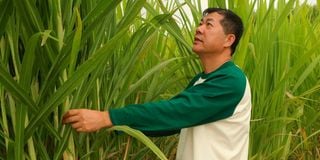Juncao grass, super feed for cattle, goats, chickens, pigs

Jack Liu, the CEO J and V Farm, tending to Juncao grass at the farm in Kampi ya Moto, Rongai in Nakuru County.
What you need to know:
- Juncao fodder can be used as feed for cattle, pigs, chickens, goats and even fish.
- It is a perennial fodder that can be harvested more than five times a year.
Farmers have a reason to smile following the introduction of high quality fodder, a hybrid of Napier, in Kenya.
Juncao fodder can be used as feed for cattle, pigs, chickens, goats and even fish.
It is a perennial fodder that can be harvested more than five times a year, with an annual yield of about 180 tonnes per acre.
Edwin Wekesa, the manager at J and V Farm in Kampi ya Moto, Rongai Sub-County in Nakuru County, says the hybrid Napier grass takes 12 weeks to mature for the first harvest.
Subsequent harvests are after eight weeks.
The feed is expected to alleviate poverty as sustainable fodder. The technology used in producing it can be applied in mushroom as food concentrate.
Wekesa says the grass has crude protein content of 18.60 per cent, making it superior to ordinary Napier which stands at 11 per cent.
For whole maize, the protein content is 8.4 per cent.
“It is easy to grow, is less labour intensive and has broad leaves that outweigh the growth of weeds,” Wekesa says, adding that Juncao Napier is resistant to pests, diseases and can grow up to six metres tall.
The farm manager says the grass can be fed directly to livestock from the farm or used as silage.
“Juncao grass can be crushed to powder by machines that are fitted with specialised sieves of different sizes for different animals,” he says.
J and V Farm Managing Director, Jack Liu, says the land under Juncao is 50 acres.
The Kenya Plant Health Inspectorate Service(KEPHIS) has allowed the introduction of Juncao grass in Kenya from China.
“Another 100 acres of land will be under Juncao by the end of November,” Liu says.
The farm has hired more than 200 young Kenyans. There are similar Juncao projects in Nakuru, Turkana, Garissa, Kajiado and Makueni counties.

Jack Liu, the CEO J and V Farm, displays Juncao grass cuttings at the farm in Kampi ya Moto, Rongai in Nakuru County.
The agriprenuer says he took the decision to invest in the grass upon realising that demand for fodder in Kenya was high but supply was low.
He also wanted to offer a viable solution to conflicts between herders and crop producers.
“Droughts in Kenya wipe out hundreds of thousands of animals every year. Pastoralists, who mostly are subsistence farmers, suffer heavy losses. The problem is cyclic,” he adds.
Juncao grass was developed in Fujian Province, China, in 1980s. It has since spread into more than 100 countries.
It appears like the ordinary Napier grass, with broad leaves but is less hairy.
To set up the enterprise, Liu needed Juncao stem cuttings sourced from China.
From experience in China, Liu says Juncao holds the key to poverty eradication.
The grass, he says, helps address forage shortages.
“It also stops soil erosion and desertification,” Liu says.
He also needed a baler, which the farm now uses to compress cut or racked fodder.
Juncao can thrive in most local climatic conditions, even regions with temperatures as low as five degrees Celsius.
A kilogramme of Juncao grass goes for Sh20.
Liu says when fed to dairy cows, it can boost milk yield by up to 40 per cent.
“Beef cattle can attain 500 kilogrammes in 12 months when given Juncao. This makes growing the grass commercially viable,” Liu says.
According to the J and V Farm Managing Director, an acre of Juncao can sustainably feed 20 cows, some 200 goats and 1,000 chickens and fish for a year.
J and V Farm expects to begin producing mushrooms by early next year.
Rwanda is already growing mushrooms through Juncao grass technology.
“Our technology is ecological as a green barrier in controlling desertification and soil degradation,” Liu says.





